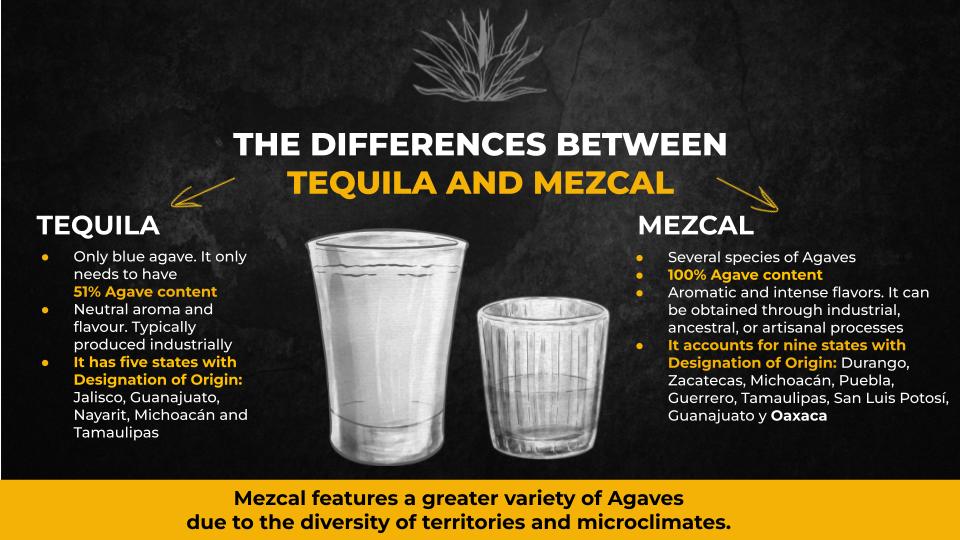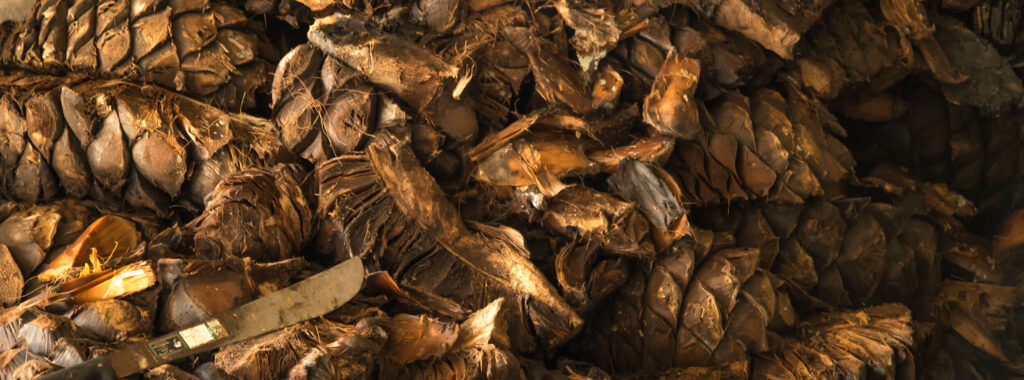The Smoky Flavor of Mezcal
Mezcal is a distillate that, unlike tequila, is characterized by its distinctive smoky aroma and flavor. But where does this subtle smokiness come from? Let’s explore the roots of mezcal, its deep connection to Mexican tradition, and the unique production process that gives it this unmistakable taste.
The Cultural Importance of Mezcal
Mezcal in Mexican Tradition
Mezcal holds a sacred place in Mexican culture. Recognized by its Denomination of Origin (DO), this spirit is produced in nine states: Oaxaca, Durango, Guerrero, Guanajuato, Michoacán, Puebla, San Luis Potosí, Tamaulipas, and Zacatecas. Oaxaca is the heart of mezcal production, accounting for nearly 90% of its total output.
The Etymology of Mezcal
The word “mezcal” originates from the Nahuatl term “Mexcalli,” which translates to “cooked maguey.” This ancient name highlights the crucial part of mezcal production that defines its smoky essence: the cooking of the agave heart.
The Production Process and Its Influence on Flavor
The Role of Agave in Mezcal’s Taste
Mezcal is made from over 30 varieties of agave, each contributing unique flavor profiles. Some popular types include:
- Espadín: The most commonly used agave, offering a balanced and slightly sweet taste.
- Tobalá: A wild agave known for its complex and floral notes.
- Tepeztate: A slow-growing variety with a bold, herbal flavor.
- Cuishe: Produces earthy, mineral-rich mezcal.
Traditional Cooking Process
The signature smokiness of mezcal originates from its cooking process. Unlike tequila, which is steamed, mezcal’s agave hearts (or piñas) are roasted in underground pit ovens. Here’s how it works:
- Pit Oven Preparation: A large hole is dug and filled with river stones or volcanic rocks, which can withstand extreme heat.
- Wood Selection: Firewood, often pine or mesquite, is ignited to heat the stones.
- Agave Placement: Once the rocks are red-hot, the agave piñas are placed in the pit.
- Sealing the Oven: Layers of maguey fibers, earth, and dirt cover the pit, allowing the agave to roast slowly for three to five days.
- Cooling Period: After cooking, the agave rests to develop its characteristic flavors before fermentation begins.
Why Some Mezcals Are Smokier Than Others
While all mezcals have a smoky component, excessive smokiness is not necessarily a sign of high quality. Some factors that influence the intensity of the smokiness include:
- Overcooking: If the agave piñas are burned instead of properly roasted, the final product will have an overpowering charred taste.
- Artificial Smoke Infusion: Some producers enhance smokiness by artificially introducing smoke into storage containers, creating an exaggerated and sometimes unbalanced flavor.
Comparing Mezcal and Tequila

| Feature | Mezcal | Tequila |
|---|---|---|
| Agave Varieties | 30+ species | Primarily Blue Weber |
| Cooking Process | Roasted in underground pits | Steamed in autoclaves |
| Production Regions | 9 states | Primarily Jalisco |
| Distillation | Clay or copper stills | Industrialized steel stills |
| Flavor Profile | Smoky, earthy, complex | Sweet, floral, clean |
Unlike mezcal, tequila’s cooking process involves steaming the agave, resulting in a fruitier, less smoky profile. This fundamental difference makes mezcal a more artisanal and traditional spirit.
Enjoying Mezcal the Right Way
How to Savor Mezcal’s Smoky Complexity
To fully appreciate mezcal’s nuanced flavors, follow these steps:
- Use the Right Glass: A traditional copita (wide clay cup) allows the aromas to develop.
- Smell Before Sipping: Take a deep inhale to detect the smoky, herbal, and fruity notes.
- Sip Slowly: Let the mezcal coat your tongue, savoring the complexity.
- Pair with Orange and Sal de Gusano: A slice of orange with worm salt enhances the experience.
Mezcal’s signature smoky flavor is a direct result of its traditional cooking process, rooted in centuries of Mexican heritage. Every sip tells a story of fire, earth, and craftsmanship, making it a spirit worth savoring. Whether you enjoy it neat or in a cocktail, mezcal is a true celebration of Mexico’s rich cultural and natural diversity.
See more: The History of Mezcal: From Ancient Traditions to Modern Masterpieces
